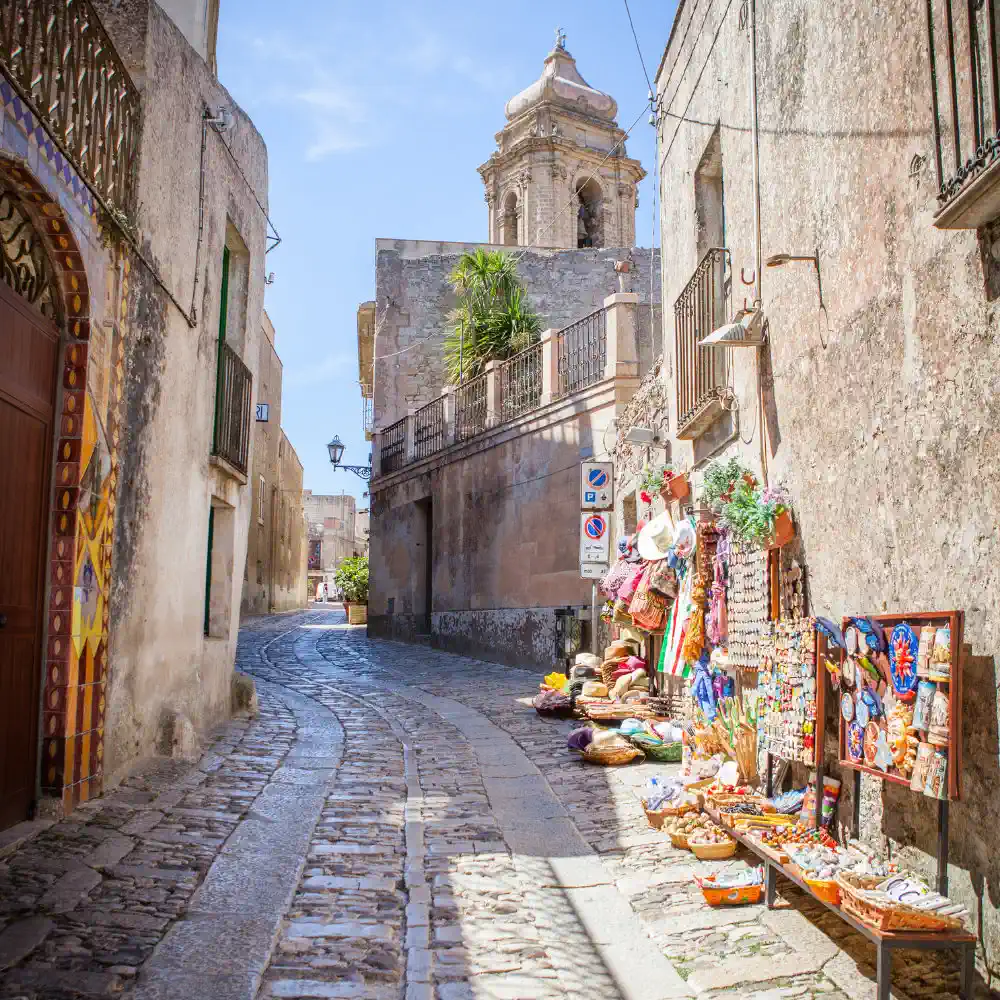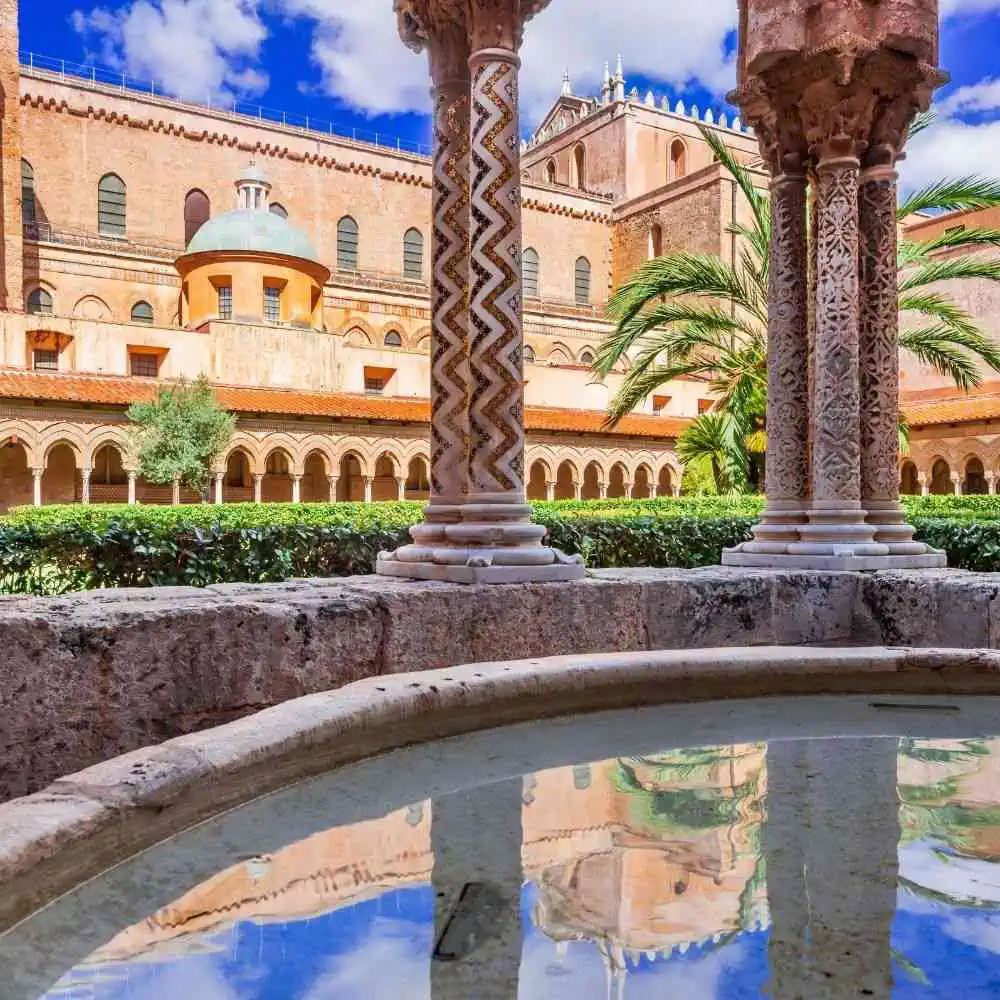You will depart from Palermo Centrale, located right in the city center of Palermo, and enjoy the beautiful scenery of the journey while you arrive in Trapani, also located in the heart of Trapani.
Trains from Palermo to Trapanifrom € 30.00
Trains from Palermo to Trapani
Travelling by train: Palermo - Trapani
Have you ever dreamt of exploring the breathtaking beauty of the Italian island of Sicily? Now, imagine embarking on an unforgettable train journey from the vibrant city of Palermo to the charming coastal town of Trapani. Get ready to experience the true essence of this enchanting region, as we guide you through the shortest route, the main stations, the distance, and the iconic elements you'll encounter along the way.
Embark on an Efficient RouteBy opting for the shortest duration, your journey from Palermo to Trapani will take approximately 2 hours and 30 minutes. Get ready for an efficient and comfortable ride through the captivating landscapes of Sicily.
Main Stations and Picturesque RoutesYour adventure begins at Palermo Centrale, a vibrant hub located in the heart of the city. As the train glides through the countryside, you'll feast your eyes on picturesque surroundings that meld crystal-clear waves with endless stretches of vineyards.
During your journey, the train will make stops at Alcamo Diramazione, a charming town known for its medieval architecture, and Marsala, renowned for its magnificent vineyards and unique fortified wines. Don't forget to explore the beautiful town center of Marsala, with its narrow streets adorned with vibrant bougainvillea.
An Iconic Departure and ArrivalAs you bid farewell to Palermo, immerse yourself in the magical atmosphere of its Massimo Theater, one of the largest opera houses in Europe. Its neoclassical architecture and grandeur will leave you in awe.
Upon arriving in Trapani, take in the breathtaking views of the Torretta Pepoli Tower. This iconic landmark offers panoramic vistas of the azure sea, the Egadi Islands, and the picturesque old town of Trapani.
In conclusion, a train journey from Palermo to Trapani offers a perfect blend of convenience, stunning scenery, and cultural delights. So grab your ticket, hop on board, and let this enchanting experience transport you to the charming world of Sicily.

Journey details
How long does the train from Palermo to Trapani take?
The train journey from Palermo to Trapani takes approximately 1 hour and 30 minutes.
What is the fastest journey from Palermo to Trapani by train?
The fastest journey from Palermo to Trapani by train is with the high-speed Intercity train, which takes around 1 hour and 15 minutes.
How much does the train cost from Palermo to Trapani?
The train ticket from Palermo to Trapani costs around €10 to €15.
How much does the Palermo to Trapani?
Yes, there is a direct train from Palermo to Trapani available, which makes the journey convenient and hassle-free.What is the distance from Palermo to Trapani by train?
The distance between Palermo and Trapani by train is approximately 100 kilometers.
Which are the cities that the train stops from Palermo to Trapani?
The train from Palermo to Trapani makes stops at several cities along the way, including Cinisi, Carini, and Alcamo.
Buy train tickets from Palermo to Trapani
Traveling by train from Palermo to Trapani is an easy and comfortable journey. RailClick is the best way to travel Europe by train.
Palermo: Places to see
Palermo is an ancient city located on the north coast of Sicily, Italy, with a varied and vibrant history of invasions and cultures. It's no wonder that the city is home to some of the best historical and architectural sites in the world. From stunning ancient Greek ruins, to ornate Baroque palaces, to secret underground tunnels and tombs, a visit to Palermo is not complete without a trip to these seven essential sites.
Teatro Massimo: The Teatro Massimo is the largest opera house in Italy, and one of the most impressive works of architecture in the city. Built in 1875 by famed Italian architect Ernesto Basile, visitors can explore the ornate interiors and admire the beautiful marble details. Hours are from 9 am to 6 pm daily, and entrance fees are 12 euros.
Palazzo dei Normanni: This Palatine Chapel, built between the 9th and 11th centuries, is the oldest royal residence in Europe. Known for its grandeur and Arabian inspirations, the palace has been home to some of the most influential kings in Sicilian history and is open from 8:30 am to 5:30 pm, daily, with 8 euros entrance fees.
Catacombe dei Cappuccini: Containing the remains of more than 8,000 people, this Catacomb is one of the biggest ossuaries in the world. Located below the Capuchin Monastery, the site is a chilling and remarkable reminder of the city’s past. Tickets cost 5 euros and it is open from 8:30am to 12:30pm and from 3:30pm to 7:00pm.
Quattro Canti: Located at the historical center of the city, the Quattro Canti is a Baroque city square marked by four impressive palazzi and four sculptures of the city's four patron saints. Admire the architecture of the square, and then enjoy a gelato at one of the nearby cafés.
Cathedral of Palermo: This impressive Norman-Byzantine style cathedral is the city's most important religious monument, and the only building that survived the 1693 earthquake. The Cathedral offers free entrance and is open from 7:30 am to 1 pm daily.
Cubo di San Lorenzo: Also known as the Church of San Lorenzo, this mysterious and ancient site is one of the oldest churches in Palermo. Visit the ruins and then explore the nearby market for some of the best street food in the city. Hours are from 7:30 am to 5 pm, and entrance is free.
Cappella Palatina: Built by Norman King Roger in the 12th century, this exquisite chapel is full of intricate Byzantine mosaics and Moorish decorations, and is considered a masterpiece of Norman architecture. The chapel is open from 9 am to 6 pm daily and charges an entrance fee of 5 euros.
Palermo is an amazing city with a rich history that is sure to enthrall any traveler. From awe-inspiring art and architecture to delicious Italian food, a visit to Palermo is sure to be memorable. Be sure to include these seven must-see places on your next trip to the city for a truly unforgettable experience.

Trapani: Places to see
Welcome to Trapani, a picturesque city located on the western coast of Sicily, Italy. Known for its rich history and stunning architecture, Trapani offers a blend of ancient ruins, medieval structures, and charming streets lined with pastel-colored houses. Let me guide you through the must-visit historical and architectural sites, as well as what delicious dishes to try during your visit.
The Cathedral of San Lorenzo: A magnificent example of Sicilian Baroque architecture, this cathedral dates back to the 14th century. Admire its stunning façade adorned with sculptures and intricate details while exploring the grand interiors that house beautiful artworks.
Palazzo della Giudecca: Situated in the historic Jewish quarter, this medieval palace showcases a mix of Norman, Gothic, and Moorish architectural styles. Marvel at its ornate decorations and visit the attached museum to learn about the history of Trapani's Jewish community.
The Tower of Ligny: Located on the northernmost tip of Trapani's old town, this 17th-century watchtower offers panoramic views of the surrounding coastline. Explore its museum dedicated to maritime history and enjoy the breathtaking vistas.
Santuario dell'Annunziata: This sanctuary is renowned for its stunning marble portal and beautiful frescoes. Visit during the Feast of the Assumption in August to witness the grand procession where the statue of the Madonna is carried through the streets.
The Salt Pans: Just outside of Trapani, the salt pans are a unique sight. Witness the centuries-old tradition of salt extraction and take in the picturesque scenery of the pink-hued salt flats against the backdrop of windmills.
Pepoli Regional Museum: Housed in a former Carmelite convent, this museum showcases an impressive collection of artifacts, including ancient pottery, sculptures, and medieval manuscripts. Explore rooms dedicated to the history, art, and archaeology of Trapani.
The Church of Purgatory: Known for its iconic "Mysteries," a collection of life-size wooden sculptures, this church is a testament to Trapani's deep religious traditions. Admire the intricate craftsmanship and witness the solemn processions during Easter.
When it comes to food in Trapani, make sure to indulge in regional specialties such as couscous di pesce (fish couscous), arancini (rice balls), and cannoli (sweet ricotta-filled pastries). Pair your culinary delights with a glass of local Alcamo white wine for an authentic Sicilian experience.
With its remarkable historical sites and delicious cuisine, Trapani is the perfect destination for travelers seeking a blend of culture and gastronomy. Immerse yourself in the city's rich heritage and flavors for an unforgettable experience.

Palermo: Main train stations
Palermo is a city located in Italy, and the most important train station is called Palermo Centrale. This is the main railway station, but the city also offers other small train stations depending on the direction of the journey, for example Notarbartolo and Montelepre.
Palermo Centrale is located at Piazza Giuseppe Garibaldi 120, close to many points of interest like the Teatro Massimo and the Arab-Norman cathedral. The opening hours are from 5:00am to 1:00am every day. At the station you can find useful services like the information office (open from 8:00am to 8:00pm) and luggage storage (open from 5:00am to 11:00pm). The contact telephone number is +39 091 641 0333.
- Palermo Centrale
- Palermo Lolli
- Palermo Francia
- Palermo Notarbartolo
- Palermo Brancaccio
- Palermo Tommaso Natale
- Palermo Fiera
- Palermo Giachery
- Palermo Roccella
- Palermo San Lorenzo
- Palermo Vespri
- Palermo La Malfa
Trapani: Main train stations
If you're planning a trip to Trapani, Italy, the main train station you'll want to familiarize yourself with is Trapani Centrale. As the primary railway hub of the city, Trapani Centrale is conveniently located in the heart of Trapani, making it easily accessible for travelers. In addition to Trapani Centrale, there is also Trapani Campo di Francia, another important train station in the city.
When it comes to practical information about Trapani Centrale, the station's opening hours are from early morning until late evening, ensuring that you can catch a train at almost any time of day. Additionally, if you need a place to store your luggage while exploring the city, luggage storage facilities are available at the station for your convenience.
- Trapani
Palermo - Trapani: How to get the best deals
Book in Advance:
Just like with airfares, train ticket prices tend to rise as the departure date gets closer. Booking weeks or even months in advance can save you a significant amount.
Travel During Off-Peak Hours:
Avoid traveling during peak times such as weekday mornings and evenings. Opt for midday, late evening, or mid-week rides when there's less demand.
Consider Slower Trains or non direct routes:
Express or high-speed trains might save time, but they're often pricier. Opting for regional or slower services can reduce your fare.
Look for Special Deals and Promotions:
Train operators occasionally have promotions or special deals, especially during off-peak seasons. It's worth signing up for newsletters. Additionally, there are sometimes group or return ticket discounts, so consider these options if they fit your travel plans.
- Contact Us


